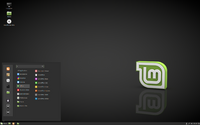Open Source Software
Introduction
Almost every piece of computer software is created using source-code. When creators release that finished product to the public, they decide whether to make their software an open-source or closed-source. Open Source Software is a program that is made available with its source code for anyone to freely edit, read, or distribute for any purpose. It is a form of open collaboration, which allows for a diverse perspective.
If a program is open-source, its source code is freely available to its users. Its users – and anyone else – can take this source code, modify it, and distribute their own versions of the program. The opposite of open-source software is closed-source software, which has a license that restricts users and keeps the source code from them. Firefox, Chrome, OpenOffice, Linux, and Android are some famous examples of open-source software, while Microsoft Windows is probably the most popular piece of closed-source software out there.[1]
History
Software development initially began as open-source, as programmers would share code with one another in order to learn. Eventually, this changed as software became more commercialized. In 1997, "The Cathedral and the Bazaar" was published by Eric Raymond, which became one factor in motivating Netscape Communications Corporations to release Netscape Communicator Internet suite as free software. The source code from this software was used to create SeaMonkey, Mozilla Firefox, Thunderbird, and KompoZer. This, in turn, prompted Raymond as well as others to begin the "Open Source Initiative" in February 1998.
A popular example of the open-source software license is the GNU General Public License("GPL"). With the GPL license, one can freely distribute, insofar as that further development of the code are also under the same GPL license (i.e., free).
Advantages
1. The main advantage of Open Source is that it is generally free and you do not have to pay for using it. This saves a lot of money for big corporations and even for ordinary users. Most licenses of the proprietary software systems are expensive and should be renewed every year. As we know, it is really important for any big company to reduce the expenses as much as possible. When Corporations are happy with the used software, they donate money to the communities in order to be able to continue their work and to develop new versions.[2]
2.Open-source software increases ownership of the end product as developers are able to view the source code and make edits. It is also highly reliable because of this, as any errors, bugs, and security concerns are easily flushed out due to so many eyes viewing the code.[3] As open source software is also easy to obtain, high-quality software is inexpensively and quickly created.
3.Open-source software is customizable and flexible. Because of this, many different "flavors" or versions of the software exist, which may be better suited to an individual's needs. Using open-source software also means you are not locked into using a particular vendor’s system that only works with their other systems.
4. According to Deborah G. Johnson, the vision of software development embraced by Free and Open Source Software is one of transparent software, software that users can modify to fit their needs, and software that widely available (including those who cannot afford to buy Private Software). FOSS programmers do nothing illegal, but they make their software available to the public, often for free and often under a license that allows users access to the source code. Much (although not all) FOSS encourages users to run, redistribute, and modify the code, although there may be user agreements with restrictions on reuse of the code.
Free Software is committed to four freedoms for software users:
1. The freedom to run the program for any purpose.
2. The freedom to study how the program works and adapt it to your needs.
3. The freedom to redistribute copies so you can help your neighbor.
4. The freedom to improve the program and release your improvements to the public so that the whole community benefits. Access to the source code is a precondition for this. (see http://www.gnu.org/philosophy/free-sw.html).
Disadvantages
1. Some interfaces are not so user-friendly and easy to use. If more attention tends to be paid to the functionality than the user interface, making some of the scripts a real pain for the novice. If you plan to incorporate such software in your company, keep in mind that your employees may need to be specially trained in order to operate it properly.
2. In most cases, you should rely on the corresponding community or pay for external supporting service, which is quite ok if you are using a popular software with lots of followers, but can be a heavy burden for less caught on applications.[4]
3. Vulnerable to malicious users. Many people have access to the source code of open-source software, but not all of them have good intentions. While a lot of people utilize their access to spot defects and make improvements to the program, others use this privilege to exploit the product’s vulnerabilities and create bugs that can infect hardware, steal identities or just annoy other users. These rarely happen with commercially produced software since the companies who make them have stringent quality control processes and ensure that the program is almost perfect when released to the market.[5]
4. No support exists for open-source software.Once you decide to use open source software, you are on your own. Agreed that lots of help is available on the Internet, and there are many self-motivated forums that can help you install and run open-source software, there is no qualified support available. You have to figure out on your own how to install and use applications without sabotaging your data and hardware. For instance, every second kid in the neighborhood exhorts you to ditch Windows and switch to Linux; many have lost their years of data trying to make the shift. No help documents and manuals are made available since the software is being changed every second week. [6]
Examples of Open Source Software
| Desktop Operating Systems: | Linux is a Unix-Like OS, based on GNU. There is some controversy over the naming of Linux, on whether it should be GNU/Linux or simply Linux. | |
| Mobile Operating Systems: | Android is a mobile operating system based on Linux. | |
| Web Browsers: | Firefox is an open source browser developed by the Mozilla foundation. |
Audacity[7]
Audacity is an easy-to-use, multi-track audio editor and recorder for Windows, Mac OS X, GNU/Linux and other operating systems. Developed by a group of volunteers as open source. Audacity is a free and open-source digital audio editor and recording application software. Audacity was started in the fall of 1999 by Dominic Mazzoni and Roger Dannenberg at Carnegie Mellon University and was released on May 28, 2000 as version 0.8. The software is extremely user freiendly.
- ↑ https://www.howtogeek.com/129967/htg-explains-what-is-open-source-software-and-why-you-should-care/
- ↑ https://www.webhostface.com/blog/advantages-and-disadvantages-of-open-source-software/
- ↑ "Benefits of open source software" http://opensourceforamerica.org/learn-more/benefits-of-open-source-software/
- ↑ https://www.webhostface.com/blog/advantages-and-disadvantages-of-open-source-software/
- ↑ https://connectusfund.org/7-main-advantages-and-disadvantages-of-open-source-software
- ↑ http://opensourcetechnologies.blogspot.com/2008/06/disadvantages-of-open-source-software.html
- ↑ https://www.audacityteam.org/



